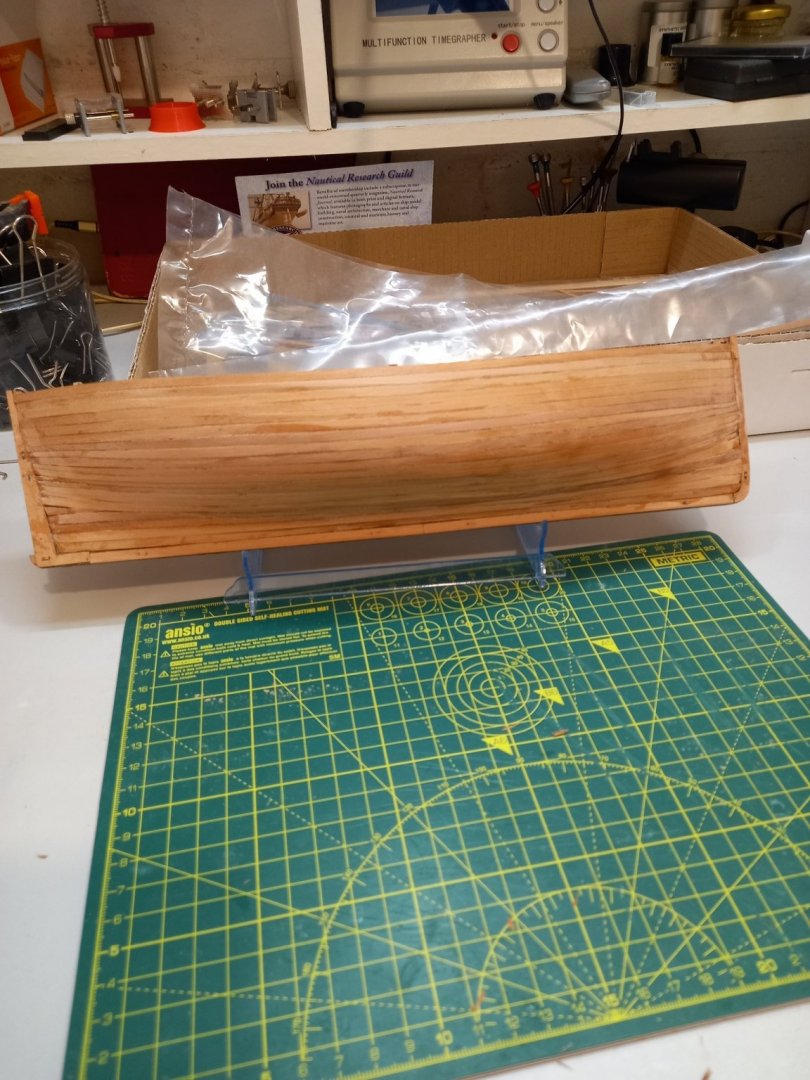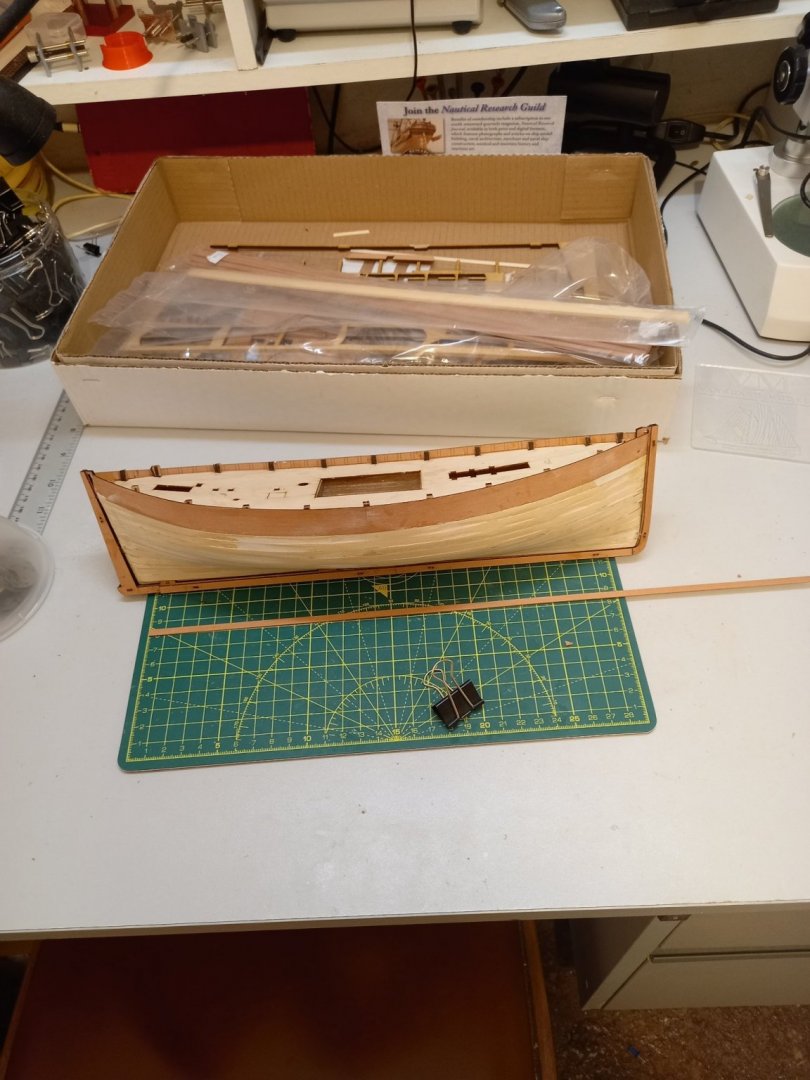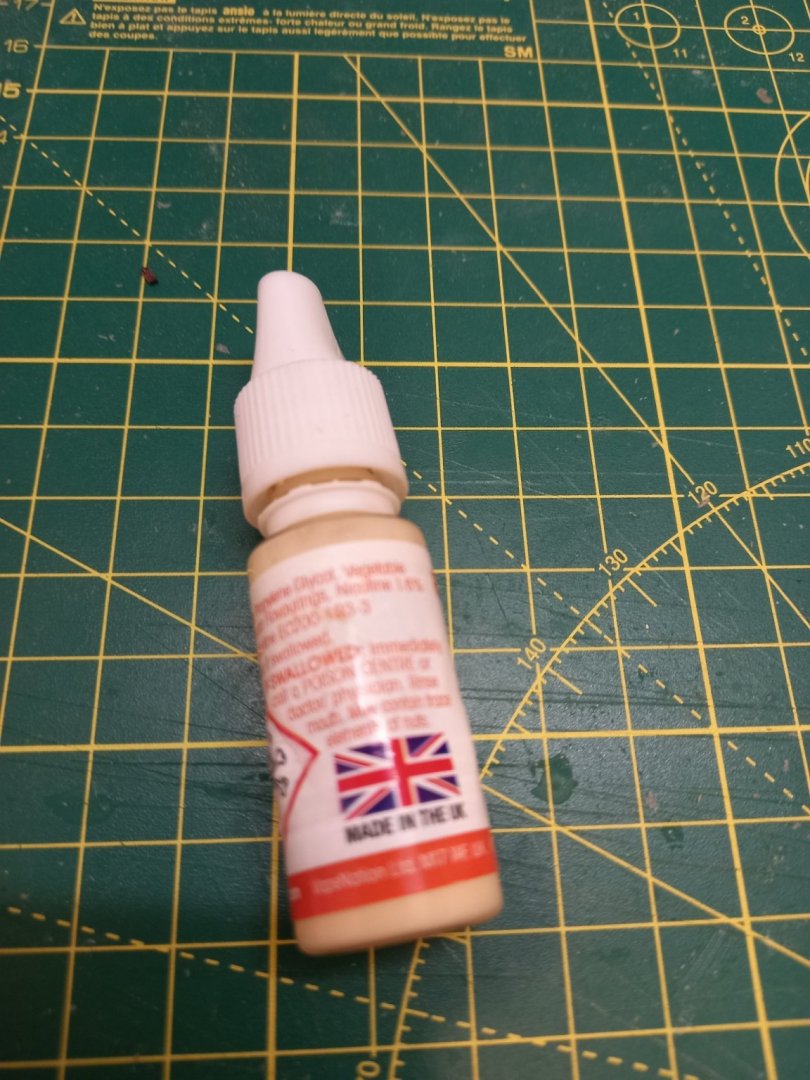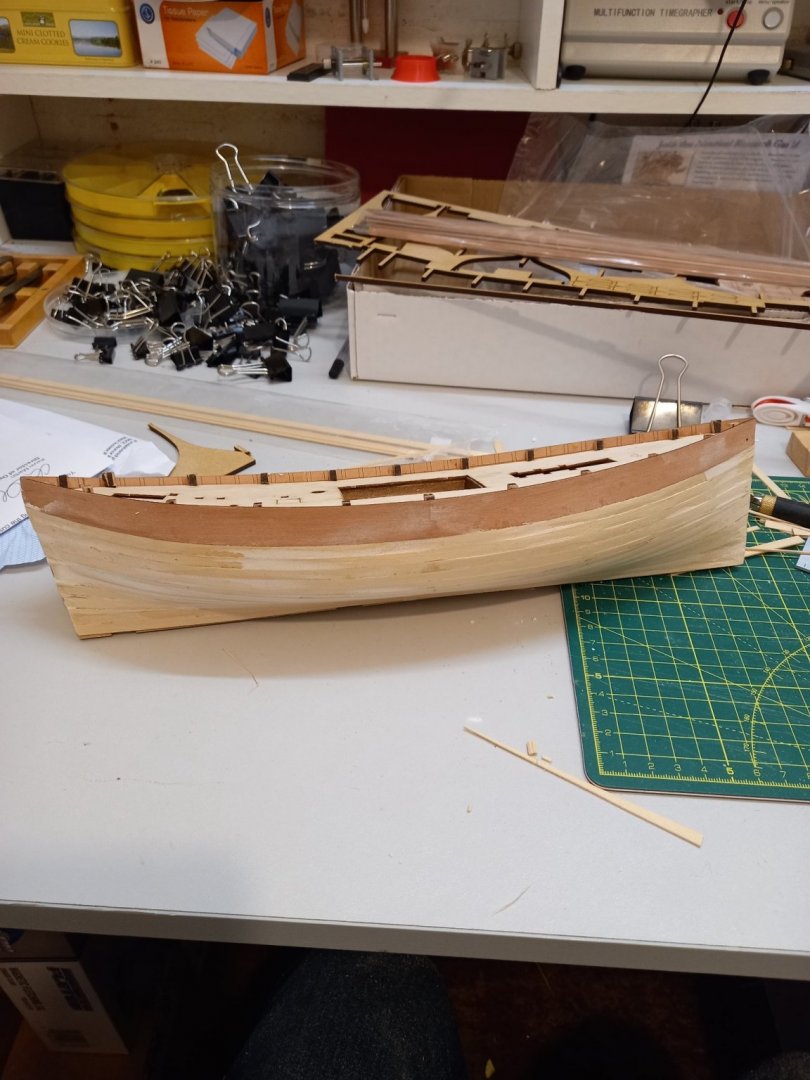
Steve G
-
Posts
59 -
Joined
-
Last visited
Content Type
Profiles
Forums
Gallery
Events
Posts posted by Steve G
-
-
Slightly reluctant to post this pic as it does not show the good bits and seems to highlight the poor bits. But, I know the trimming at the bow and stern are not all they could be, but I have a cunning plan.
Amazed at how much sanding is needed to get this right. I'm only about 1/4 the way through and a lot more to do. I tend to work for about 20min and then have a good few hours break. It allows me to rationalise the task better.
- chris watton, JpR62, AJohnson and 1 other
-
 4
4
-
Second planking now done. It's a bit 'curates egg', but I'm on the sanding job now, secure in the knowledge that it it don't pan out as I hope, I can, with a clear conscience, paint it!
But I'm happy so far.
- chris watton and AJohnson
-
 2
2
-
-
After a bit of a break I've recommenced the Hull planking and am quickly discovering that the minor and, as I thought, insignificant errors made earlier in the build are coming back to bite me.
I don't mind too much as I very much consider this to be my learning experience and in some ways, making these mistakes early on is a good thing as it prepares me for my next adventure, and I still intend to make as good a job of this as I can.
Fortunately, from my previous experiences, the only people who will see the mistakes are people who build these things themselves and there are precious few in the circles I associate with.
- DelF, Rik Thistle and AJohnson
-
 3
3
-
After a LOT of sanding, I've fitted the keel and am about to start second planking. If anyone wants to donate some vellum, please PM me.
It actually looks a lot better in the flesh than on the photo
-
-
4 minutes ago, wefalck said:
Yes, but one can/has to convert them in to JPG at home, in the digital lab. So, I never clogged up the memory cards with these, even though all of my digital DSLRs had the possibility to save both formats at the same time.
Fair enough, each to their own, but I find the jpeg a good reference point before I manipulate the RAW image, particularly for things that can't really be corrected in PS, I use it more for editing out the discards than anything else.
-
1 minute ago, Rik Thistle said:
After a LOT of sanding,
🙂 Yup, I know the feeling.
I think some of my first planking was sanded almost paper thin in places and I was worried that the 2nd planking would have nothing substantial to hang on to.... but it turned out OK.
I think the reason mine was paper thin was to compensate for not sanding the bulkheads correctly in the first place. On my next hull I will put a lot more effort into getting the bulkhead contours correct rather than charging through that part of the build (...he says).
Anyway, she's definitely starting to look like a Fifie!
Richard
Cheers Richard. I'm constantly referring to your and BEs build log.
This is so far out of my comfort zone I could be on another planet. Thankfully, the kit and instructions are incredibly well put together and the encouragement offered on here is priceless.
-
13 minutes ago, wefalck said:
You must have been a very observing child !
I remember that my father told me about the colours of shadows etc. and he also had various books, some of them dating back to the 1940s, on colour photography that I read in my teenage years and that I still have.
I never had the possibility to set up a colour lab, so I never had the possibility to manipulate prints, but it was always on my mind how to change this or that on the image. When reasonably priced slide scanners came onto the market, this opened up this possibility and over the last 15 years or so, of course digital photography.
And I agree, the function in Adobe Photoshop to manipulate 'highlights and shadow' is very useful and I use it frequently to make up for less than ideal lighting. This is a situation one frequently encounters during travelling, when there is no time to wait for different light/weather, or in museums, where one depends on what light is put there.
I find Photoshop particularly useful to manipulate images taken in museums for information purposes, not to make 'nice' or technically 'correct' photographs. In these 'technical' photographs it is important (for me) to be able to identify details, even on the expense of 'white noise', when light levels are low. As I always shoot in RAW, I can also adjust the white balance, if needed.
Again, using the RAW-format to save the primary image gives one the possibility to adjust e.g. the white balance or tonality of an image in order to achieve the desired effect. I often have a specific 'picture' in mind when taking a photograph, but not always the primary image comes out like that, so the image processing software provides the tool to create this 'picture' by post-processing: http://www.imago-orbis.org
Many if not, most DSLR and mirrorless cameras give you the option to take the picture in both jPeg and RAW. It can be a very useful feature.
-
-
Oh dear. Who would have thought that a short post from a man I have never met who lives thousands of miles away could affect us so deeply.
Best wishes to you and your family from all of us in the UK.
- Edwardkenway, egkb, marktiedens and 1 other
-
 4
4
-
- Canute, Roger Pellett, mtaylor and 4 others
-
 7
7
-
31 minutes ago, Gaetan Bordeleau said:
Taking a correctly lighted photo can be difficult but we need to try to make the process as simple as possible. Lighting is the first step which will ease or complicate your task in post processing.
This is about what I like to do: I light the parts I want to photograph with LED lighting. This way, the background is black, without any black paper.
With adequate lighting, there will be no dark area to correct only the highlights when necessary. For this Lightroom is very good.
I too prefer adjustable LED lights to flash. It's much easier to control and is a damned sight cheaper! Certainly for small indoor product work, which is pretty much the same as photographing model boats.
-
13 minutes ago, wefalck said:
What you are talking about is a too high contrast in the image. Like in the old days the film, today the camera sensors can only handle a certain contrast ratio. The consequence is that 'lights' 'burn out' and 'shadows' become 'blackened out'. With post-processing, e.g. Adobe Photoshop, you can increase the apparent dynamic range, but it will increase the white noise usually. However, the colour of white or black pixels cannot be changed.
In the 'studio' you can reduce the contrast by illuminating dark areas and by using e.g. a less stark background, say grey or green instead of white or black.
When I am photographing parts for my building logs, I use a sheet of medium green paper as background. The rationale is that it provides a medium contrast, green is a less frequent colour on (my) models, so there is a good colour contrast, and a medium green is perceived by most people a soothing to the eyes (which is why we have green leather desktops, writing mats, etc.).
It is an old wisdom among photographers (knowledegeable hobbyist and professionals alike), that a a blue sky with nice white cumulus clouds is the the best light conditions, as it provides lots of lumens of diffuse white light. In consequence it is common mistake modellers make to drag their models out to the terrace or balcony on a bright sunny day without clouds. For the same reason professional photographers doing e.g. fashion shots have an army of assistants running around with diffusing reflectors on tripods - to reduce the contrast and light up dark areas.
I'd agree, but you do need a certain amount of proficiency in photoshop (or lightroom for that matter) to be able to manipulate images to get a better result than the built in microprocessor on the camera. People who use photoshop generally use less than about 5% of its capability.
I would personally not use such tiny apertures. I know that you are trying to obtain a good DoF, but the fall off with smaller apertures is quite dramatic. I think you would be better with some ND filters and use you PS skills to stack your pictures.
- mtaylor and thibaultron
-
 2
2
-
1 hour ago, Dr PR said:
Wefalck,
I had trouble seeing the "5" in the blue circle at bottom center on my laptop. But on my primary monitor, which is used by some pro photographers, the "5" stands out clearly - with both eyes.
Steve, I agree with you that lighting is very important, and in most cases I like diffused light that does not produce harsh shadows.
But you can have too much light! If part of your subject is white and part is dark, like sails and hulls, you will have difficulty getting a good exposure for the entire thing.
This is especially true for wildflower photography which I do a lot of. Sunny days with clear skies have part of the subject illuminated with harsh white light that washes out any subtle details, and shadows are illuminated by that big blue light called the sky. Colors come out strange. Cloudy bright days illuminate everything with a soft white light, allowing details to come out in the brightest parts without harsh shadows.
Often when inside I will shine a light on the white ceiling to reflect back to the ship model. I place the camera on a tripod and use very small apertures (f/22-f/40) to get good depth of field. Then I may have to use a 30 second exposure to take the picture.
Interested to read your comments. Regarding too much light. Imagine photographing a traditional wedding. The bride is in a huge white dress and the groom is in a black suit. How do you measure the light.
Well, you measure the incidence reading, not the reflected reading. You do the same in a studio with a flash meter.
- mtaylor and thibaultron
-
 2
2
-
23 minutes ago, AJohnson said:
Yes I have one of those, it is fine initially, but then I have found the blade starts cutting a groove into the plastic bed, not sure how long it is going to last, or if there is something better out there.
Looking at it, I think the plastic bed is reversible.
-
Thanks for the kind words, but I am seriously annoyed with myself. I think the self confident know it all in me came out to bite me on the bum.
I have learned a valuable lesson or two, the first one is SLOW DOWN!, the second one is its either right or wrong, don't glue it if it's wrong
I'll get there though. (It's enormous fun)
- Rik Thistle and VTHokiEE
-
 2
2
-
I've just been reading some of these posts, mine in particular, and I think I may have come over a bit strong. If I may, I'd like to give just a few pointers that may help in the subject of photographing your models.
There is a lot more to this than just pressing the shutter!
The first thing to bear in mind is who you are taking the photos for and who will be seeing them. Strange as it may seem, no one will view the picture you take the same way that you do. This is essentially what separates a pro from an amateur. Your prized picture of your boat that you think is fantastic is shows the minute detail of the blocks and rigging, the carefully carved figurehead etc . Someone else will just see a picture of a boat. Someone else will see the harsh shadows on the background of the mast. Someone else will look at the overexposed foreground and dark shadows on the deck. It's the same picture, but everyone sees it differently.
So the first thing is to decide exactly what picture you want people to see and start from there.
Lighting is utterly crucial. Before you get bogged down with camera settings, white balance, colour rendition and everything else, get your lighting right, it makes or breaks a picture.
Next, look at your composition. OK, it's a stand alone subject, but how are you going to shoot it. Sideways, head on, from above, 3/4 on? There is a myriad ways of doing it, but be careful. If you are doing 3/4 shots with a short lens it can throw out your perspective enormously. Also, short lenses can 'bend' masts and rigging. It may not be that noticeable on small pictures, but when you enlarge them...
Be careful about your background, it needs as much consideration when it comes to lighting as the subject itself does.
Also bear in mind that you are not, with your photography, creating a work of art. The work of art is already there in the shape of your model, you are merely recording it.
Some folks have talked about shooting RAW pictures. This is a great thing if you know what you are doing, basically, you record everything seen through the lens in RAW setting and you have to manipulate the image yourself to get the effect you want. Is RAW necessary for this type of photography? Probably not, but if you are competent then OK. If you don't use it, the microprocessor in the camera will do it for you automatically and, whilst never perfect, will almost certainly give you more than acceptable results.
- thibaultron, Gregory, Rik Thistle and 1 other
-
 4
4
-
I've finished the first planking. I'm not overjoyed at my efforts, I know I could have done a far better job and to most of you guys this will look pretty amateurish but it it what it is. I have enjoyed the journey so far, and the elation when that final plank goes in and it first starts to look like an actual boat is wonderful.
I'm trying to make a poor job as good as I can with some sanding and filling and hopefully will have a good foundation to take the second planking, which I hope to do a lot better than this.
Cheers
-
52 minutes ago, Justin P. said:
I actually quite enjoy the needless overthinking that happens within the hobby - and in particular, the granularity that can be achieved when that overthinking becomes a communal endeavor. Certainly a something that happens often here at MSW. 🙂
Well, I've not been here long enough to learn. But I daresay you are quite right, I'm learning a lot from some very knowledgeable people here and am very greatful for it.
- mtaylor, Scottish Guy, Matt D and 2 others
-
 5
5
-
6 minutes ago, glbarlow said:
I’m an active pro NPS photographer, I think you may be a bit out of touch. I know lots of very capable and experienced hobbyists. Just like any hobby, including modeling, there are those that express as fact expertise they don’t necessarily have. These are the ones I often see in Facebook camera groups and warrant a good laugh. There are far more who are curious, seek to learn, and produce some amazing images. It’s a mistake to generalize and assume you are the expert where others aren’t or that every “amateur” is devoid of the technical knowledge of photography and the artistic creativity necessary to produce good work.
But I am far afield of the topic of White Balance, I doubt you’ll change your views so I’ll just let it go and move on. It just bothers me that someone that was once in the field doesn’t respect the wide range of talent out there today.
It's not a question of not respecting, not at all. I never deride any photographer who actually takes photographs and is prepared to offer his/her work for appraisal. It's the ones that spend hours on the theory of digital medium and have a rudimentary grasp of its meanings yet never, or seldom take photos that are avaliable for scrutiny.
It really doesn't bother me that much to be honest, I'm not in this interest group to discuss the merits of people's photographic efforts, I'm here to learn about model ship building. My initial point was that people were overthinking the photographic element of the hobby needlessly.
I'm bowing out of this thread now as it looks like it's going to go a bit mental.
-
I am a retired ex-pro photographer.
If you want me to be brutally frank, most amateur photographers are all mouth and trousers and are very quick to pontificate on subjects that their knowledge of is, at best, sparse.
- Scottish Guy and thibaultron
-
 1
1
-
 1
1
-
1 hour ago, glbarlow said:
I shoot all my build log photos with my iPhone 12 Pro mostly because it’s a pretty good camera, in that case or casual photography for most people, like those that use Auto on their cameras, your statement might hold. Anyone doing serious photography, I offered up my website as example, certainly has a need for understanding the technical aspects of photography for a capturing a quality image. Not wave lengths or museum rules technical but definitely manipulating how the camera captures the image including in some cases managing RGB channels. Perhaps it’s a misunderstanding of “technical” in this scenario, or perhaps the camera is in Auto.
It depends on what purpose you picture is for. Most people just want a good, acceptable picture for their own use or to publish on social media. If you are talking about printed magazine reproduction then yes, you need to know about white balance, colour rendition etc. But relatively few people need this sort of technical knowledge and if they do, they are much better using a pro photographer in the first place.
- thibaultron and mtaylor
-
 2
2
-
Have to say that I'm really glad I chose this model rather than something more complex. The first planking had been a nightmare, my own fault for not researching the method properly. However, it is just about complete. I'm too embarrassed to photograph it in its present state, but will finish the minor trimming, fill and sand it and then post a pic. Hopefully it won't look too bad, and I manage the second planking without too much drama.








Lady Eleanor by Steve G - Vanguard Models - 1:64
in - Kit build logs for subjects built from 1851 - 1900
Posted
Just to let you know that I have not lost interest, it's just my workshop is so bloody cold at the moment I've put everything on hold till it warms up.
Cheers